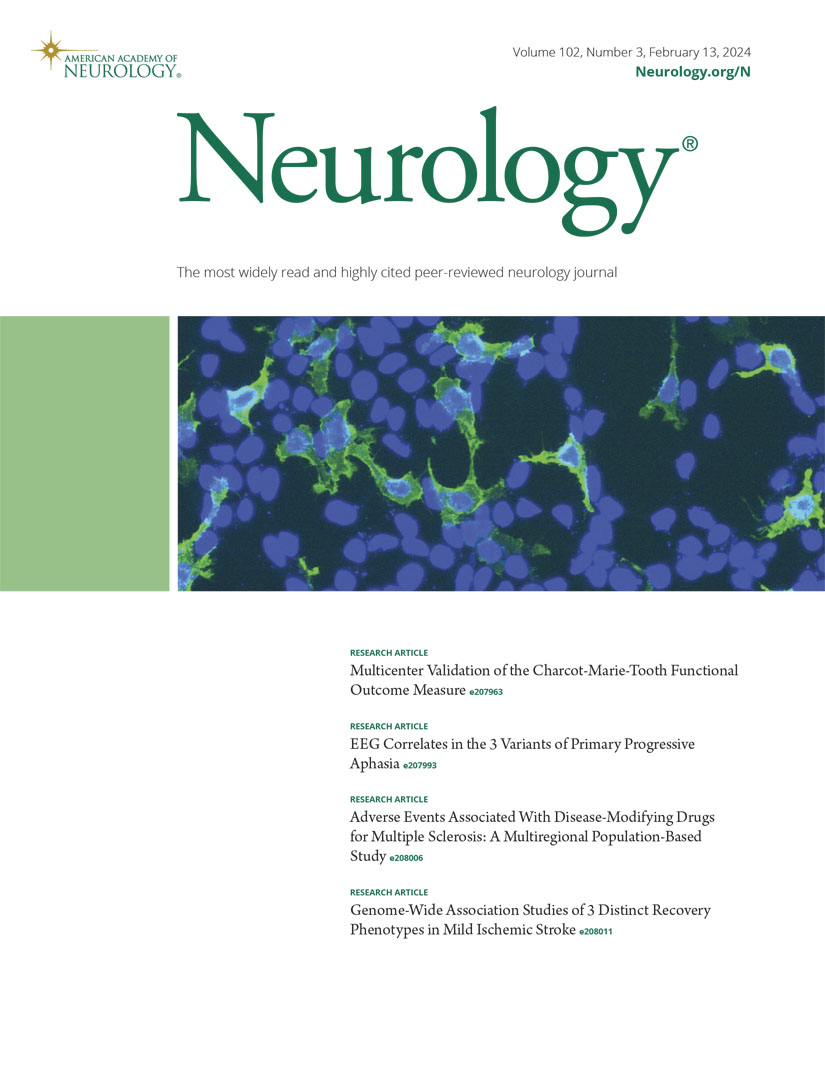Validating the Amyloid Cascade Through the Revised Criteria of Alzheimer's Association Workgroup 2024 for Alzheimer Disease.
IF 7.7
1区 医学
Q1 CLINICAL NEUROLOGY
引用次数: 0
Abstract
BACKGROUND AND OBJECTIVES The amyloid cascade hypothesis posits that Alzheimer disease (AD) progresses from amyloid deposition to tau deposition, neurodegeneration, and eventually cognitive impairment and is the foundation of the revised criteria of Alzheimer's Association Workgroup 2024 (AA-2024). To account for copathologies and cognitive resilience that affect the penetrance of the AD cascade, AA-2024 introduced a 2-dimensional biological-clinical staging framework. We aimed to estimate the proportion of persons along the AD continuum whose biological and clinical trajectories align with the amyloid cascade. METHODS Cross-sectional data of the Alzheimer's Disease Neuroimaging Initiative (ADNI) cohort were tested in the 4 × 4 biological/clinical staging matrix adapted from the AA-2024 criteria. Biological stages were defined by amyloid and tau-PET burden: stage A (amyloid positivity, A+), stage B (medial temporal tau, A+/T2MTL+), stage C (moderate neocortical tau, A+/T2MOD+), and stage D (high neocortical tau, A+/T2HIGH+). Clinical stages were cognitively unimpaired (stage 1), subtle cognitive impairment (stage 2), mild cognitive impairment (stage 3), and dementia (stages 4-6). Tau-PET cutoffs were defined through the implementation of 5 distinct methods. Participants were categorized into (1) compliant with the amyloid cascade (matrix diagonal), (2) resilient (advanced biological stage-early clinical stage), and (3) copathologic (early biological stage-advanced clinical stage). Observed distributions were compared with hypothetical scenarios with zero and high amyloid cascade penetrance using the χ2 test, and differences among the 5 methods were tested using the Cochran Q test. RESULTS Two-hundred and fifty-six amyloid-positive individuals (mean age: 72.7 years; 51% female) from the ADNI cohort were considered. The proportion of participants compliant with the amyloid cascade was between 31% (95% CI 25%-37%) and 36% (95% CI 30%-42%) depending on the tau-PET cutoff method. The observed number of individuals compliant with the amyloid cascade was higher than in the zero-penetrance scenario but lower than in the high-penetrance distribution (p < 0.01). The proportion of copathologic (17%-63%) and resilient (6%-52%) individuals varied widely by tau-PET cutoff (p < 0.001). DISCUSSION Only approximately one-third of persons with an AA-2024 diagnosis of AD complied with the predictions of the amyloid cascade hypothesis. These results suggest the heterogeneity in how clinical symptoms and pathology are coupled along the AD continuum, which has significant implications for interpreting completed antiamyloid clinical trials and designing future studies.通过阿尔茨海默病协会工作组2024年阿尔茨海默病修订标准验证淀粉样蛋白级联
背景与目的淀粉样蛋白级联假说认为,阿尔茨海默病(AD)从淀粉样蛋白沉积发展到tau沉积、神经退行性变,最终导致认知功能障碍,是阿尔茨海默病协会工作组2024 (AA-2024)修订标准的基础。为了解释影响AD级联外显率的病理和认知恢复力,AA-2024引入了一个二维生物临床分期框架。我们的目的是估计沿AD连续体的生物学和临床轨迹与淀粉样蛋白级联一致的人的比例。方法采用AA-2024标准改编的4 × 4生物/临床分期矩阵,对阿尔茨海默病神经影像学倡议(ADNI)队列的横断面数据进行测试。根据淀粉样蛋白和tau- pet负荷来定义生物学分期:A期(淀粉样蛋白阳性,A+), B期(内侧颞叶tau, A+/T2MTL+), C期(中度新皮质tau, A+/T2MOD+), D期(高新皮质tau, A+/T2HIGH+)。临床分期为认知无损伤(1期)、轻度认知损伤(2期)、轻度认知损伤(3期)和痴呆(4-6期)。通过实施5种不同的方法来定义Tau-PET截止点。参与者被分为(1)淀粉样蛋白级联顺应(基质对角线),(2)弹性(晚期生物学阶段-早期临床阶段)和(3)病理(早期生物学阶段-晚期临床阶段)。将观察到的分布与淀粉样蛋白级联外显率为零和高的假设情况进行χ2检验,并使用Cochran Q检验检验5种方法之间的差异。结果淀粉样蛋白阳性个体256例,平均年龄72.7岁;(51%女性)来自ADNI队列。根据tau-PET截止方法,符合淀粉样蛋白级联反应的参与者比例在31% (95% CI 25%-37%)和36% (95% CI 30%-42%)之间。符合淀粉样蛋白级联的个体数量高于零外显率分布,但低于高外显率分布(p < 0.01)。病理型(17%-63%)和弹性型(6%-52%)个体的比例在tau-PET截止点上差异很大(p < 0.001)。只有大约三分之一的AA-2024诊断为AD的人符合淀粉样蛋白级联假说的预测。这些结果表明临床症状和病理在AD连续体上的异质性,这对解释已完成的抗淀粉样蛋白临床试验和设计未来的研究具有重要意义。
本文章由计算机程序翻译,如有差异,请以英文原文为准。
求助全文
约1分钟内获得全文
求助全文
来源期刊

Neurology
医学-临床神经学
CiteScore
12.20
自引率
4.00%
发文量
1973
审稿时长
2-3 weeks
期刊介绍:
Neurology, the official journal of the American Academy of Neurology, aspires to be the premier peer-reviewed journal for clinical neurology research. Its mission is to publish exceptional peer-reviewed original research articles, editorials, and reviews to improve patient care, education, clinical research, and professionalism in neurology.
As the leading clinical neurology journal worldwide, Neurology targets physicians specializing in nervous system diseases and conditions. It aims to advance the field by presenting new basic and clinical research that influences neurological practice. The journal is a leading source of cutting-edge, peer-reviewed information for the neurology community worldwide. Editorial content includes Research, Clinical/Scientific Notes, Views, Historical Neurology, NeuroImages, Humanities, Letters, and position papers from the American Academy of Neurology. The online version is considered the definitive version, encompassing all available content.
Neurology is indexed in prestigious databases such as MEDLINE/PubMed, Embase, Scopus, Biological Abstracts®, PsycINFO®, Current Contents®, Web of Science®, CrossRef, and Google Scholar.
 求助内容:
求助内容: 应助结果提醒方式:
应助结果提醒方式:


